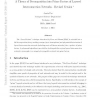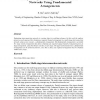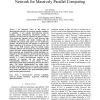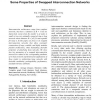117
click to vote
IAJIT
2011
14 years 4 months ago
2011
: The core of a parallel processing system is the interconnection network by which the system’s processors are linked. Due to the great role played by the interconnection network...
113
Voted
DAM
2011
14 years 7 months ago
2011
The \Cross Product" technique introduced by Even and Litman EL92] is extended into a fulldecompositiontheory enablinga unique (up to isomorphism)and polynomialfactorizationof...
90
Voted
CORR
2010
Springer
14 years 10 months ago
2010
Springer
Optimizing interconnection networks is a prime object in switching schemes. In this work the authors present a novel approach for obtaining a required channel arrangement in a mul...
116
Voted
TPDS
2002
15 years 3 days ago
2002
Abstract--The Gemini interconnect is a dual technology (optical and electrical) interconnection network designed for use in tightlycoupled multicomputer systems. It consists of a c...
98
Voted
PPL
2002
15 years 4 days ago
2002
The tree interconnection network lends itself to several suitably structured applications. However, the low connectivity at each node, traffic congestion and single point of failu...
100
click to vote
JPDC
2000
15 years 8 days ago
2000
A new class of interconnection networks, the hypernetworks, has been proposed recently. Hypernetworks are characterized by hypergraphs. Compared with point-to-point networks, they...
99
Voted
JCO
2007
15 years 11 days ago
2007
Abstract The wide diameter of a graph is an important parameter to measure faulttolerance of interconnection network. This paper proves that for any two vertices in de Bruijn undir...
107
click to vote
TC
2008
15 years 11 days ago
2008
The design and performance of next-generation chip multiprocessors (CMPs) will be bound by the limited amount of power that can be dissipated on a single die. We present photonic n...
108
click to vote
JCP
2008
15 years 14 days ago
2008
An important issues in the design of interconnection networks for massively parallel computers is scalability. A new scalable interconnection network topology, called Double-Loop H...
CIC
2004
15 years 1 months ago
2004
Interconnection architectures range from complete networks, that have a diameter of D = 1 but are impractical except when the number n of nodes is small, to low-cost, minimally co...






